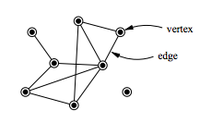
Photo from wikipedia
The development of drugs to restore protein function has been a major advance facilitated by molecular medicine. Allosteric regulation, a phenomenon widely observed in nature, in which a molecule binds… Click to show full abstract
The development of drugs to restore protein function has been a major advance facilitated by molecular medicine. Allosteric regulation, a phenomenon widely observed in nature, in which a molecule binds to control a distance active site, holds great promise for regulating proteins, yet how to rationally design such a molecule remains a mystery. Over the past few years, we and others have developed several techniques based on molecular dynamics (MD) simulations: MD-Markov state models to capture global conformational substates, and network theory approach utilizing the interaction energy within the protein to confer local allosteric control. We focus on the key case study of the p53 Y220C mutation restoration by PK11000, a compound experimentally shown to reactivate p53 native function in Y220C mutant present tumors. We gain insights into the mutation and allosteric reactivation of the protein, which we anticipate will be applicable to de novo design to engineer new compounds not only for this mutation, but in other macromolecular systems as well.
Journal Title: ACS Omega
Year Published: 2022
Link to full text (if available)
Share on Social Media: Sign Up to like & get
recommendations!